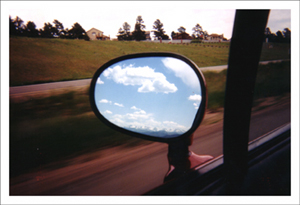Road Reverie—Process Notes
Road Trip is really all about curiosity. It began as a way to answer questions I had about cyberspace's potential for all things literary by plunging me not only into ever-and-ever-and-ever expanding and linking research, but also by challenging me to learn how to present my answers in a cyberspace fashion. The result was Road Way.
I could have stopped there, but my overactive curiosity wouldn't let me. While my scholarly questions were answered, my creative writing juices were now bubbling with nowhere to go, or so I felt. While I came away deeply impressed with the cyberlit works I'd discovered during my creation of Road Way, I also came away with the nagging concern that the technological expertise needed to create such works placed cyberspace out of reach for the average creative writer not inclined, time-wise or skill-wise, to master cutting-edge technological know-how.
Could there be a way to allow the rest of us in on the discovery fun? A creative cyberlit experiment seemed a good way to round out the trip. Surely any self-respecting creative writer would at least give it a try.
So I set up one more challenge for myself: Using only the most basic of web design skills, the rudimentary HTML skills, my goal was to see if I could create a piece that looked, if not cutting-edge modern, then at least clean and inviting. I wanted to play with linking, fonts, and colors without the complicated and expensive technology used by most cyberwriters today, while avoiding the appearance of someone's home page or Facebook template.
But I also wanted, using only the most basic code skills, to try to go further than much of the print text cyber-based literature available, which is, at its core, nothing very different from a bound book or magazine entry plus scrolling. Using the same template created for Road Way and my new basic code skills, I began to play. And learn. All over again.
Lessons and Observations—"Ah-ha" and "Hmm" Moments
Just as I did as a researcher creating Road Way, I experienced "ah ha" and "hmm" moments galore, but this time from a writer's point of view. In Road Reverie, I learned that even inside the smallest parameters of hypertextual linkage, cyberspace can offer a different creative writing experience—from how one thinks about "audience" while creating such a work to how one presents creative pieces for best cybertextual and literary effect. Inside the short pieces chosen for Road Reverie (some purposefully very, very short since that seems to be cyberlit's most effective form), I linked to sites that expanded the readings, but I tried creating original links just for the individual works as well.
I also found myself coping with a whole other set of questions, such as: How many links are too many? Where to place links so they add, not detract, from a cyberlit reading? What links would be clever and enjoyable? What links are not? Answering them was a lesson in itself about the use of cyberspace as writing space.
Of course, sticking to my novice code skills created its own limits in structure. But from a content point of view, there were no limits at all. Cyberspace's lack of boundaries forces the creative writer to 1) set his or her own boundaries in hopes of avoiding the look and sound of amateur cyberjunk, and 2) learn to self-edit, a valuable skill to attain as fast as humanly possible when faced with such freedom, unless public embarrassment is a source of joy. Nowhere is self-editing more needed than in the instantaneous cyberspace milieu where the word "publish" is a term used for a click.
As for the content itself, I began with several pieces of my literary travel writing that were short magazine-style articles—"The Change," "Middle of Nowhere," "The Cop," "The Picture Window," and "Not the Sangria"—throwing in a bit of linkage. Next, I added a batch of jotted travel moments such as "The Bathroom Wall," "The Bumper Poem" and "The Silence," created especially as cyberlit, taking advantage of the extras that cyberspace as literary space offered. As I did, I experienced how the milieu changed my conception of ideas and form in playful, non-structured ways. One example: The reimagining of the staid idea of footnoting, as seen in "The Reason." As for Road Site-seeing Attractions, I chose a few cyberlit works and cyber-centric travel-related sites and sprinkled in some well-chosen traveling quotes. The end result is Road Reverie.
But, really, it didn't feel like an end. So I decided it would be an "in progress" entity. Why? An "in progress" status plays into the most interesting cyberlit difference beyond the printed page—its forever changeability—always waiting for the input of new creative ideas and further technological expertise. Just like real life and real traveling. And just like these process notes, created years after the original text, serve to further reflect on the initial in-progress work.
"Reverie"—a state of creative mind
Why did I name this a Road "Reverie?" The word "reverie," so says the dictionary, is a "a state of being pleasantly lost in one's thoughts." On the road trip that is every creative writer's journey, that is a state in which we're always traveling. Road Reverie is something between a travel diary and a hypertext slide show of moments—serious, comic, contemplative, exciting, poignant, whimsical—all presented in a experience-expanding way for any reader that no printed form can touch. I hope it entertains and enlightens as all creative writing should do in whatever medium. And for those creatively inclined, I hope it shows what can be done with a simple knowledge of code. From here, you're on your own. Every road has a starting place.
| Road Reverie |
| A cyberlit travel memoir experiment-trip in progress
|
 |
Return Home